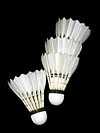Shuttlecock


A shuttlecock (previously called Shuttlecork) (also called a bird or birdie)[1] is a high-drag projectile used in the sport of badminton. It has an open conical shape: the cone is formed from 16 or so overlapping feathers, usually goose or duck, embedded into a rounded cork base. The cork is covered with thin leather.[2] The shuttlecock's shape makes it extremely aerodynamically stable. Regardless of initial orientation, it will turn to fly cork first, and remain in the cork-first orientation. The name shuttlecock is frequently shortened to shuttle. The "shuttle" part of the name was probably derived from its back-and-forth motion during the game, resembling the shuttle of a loom; the "cock" part of the name was probably derived from the resemblance of the feathers to those on a cockerel.
Feathered vs. synthetic shuttlecocks
The feathers are brittle; shuttlecocks break easily and often need to be replaced several times during a game. For this reason, synthetic shuttlecocks have been developed that replace the feathers with a plastic skirt. Players often refer to synthetic shuttlecocks as plastics and feathered shuttlecocks as feathers.
The cost of good quality feathers is similar to that of good quality plastics, but plastics are far more durable, typically lasting many matches without any impairment to their flight.
Most experienced and skillful players greatly prefer feathers, and serious tournaments or leagues are always played using feather shuttlecocks of the highest quality.[3] Experienced players generally prefer the "feel" of feathered shuttlecocks and assert that they are able to control the flight of feathers better than of plastics. In Asia, where feather shuttlecocks are more affordable than in Europe and North America, plastic shuttlecocks are hardly used at all.
The playing characteristics of plastics and feathers are substantially different. Plastics fly more slowly on initial impact, but slow down less towards the end of their flight. While feathers tend to drop straight down on a clear shot, plastics never quite return to a straight drop, falling more on a diagonal. Feather shuttles may come off the strings at speeds in excess of 320 km/h (200 mph) but slow down faster as they drop. For this reason, the feather shuttle makes the game seem faster, but also allows more time to play strokes. Because feather shuttles fly more quickly off the racquet face they also tend to cause less shoulder impact and injury.
Specifications
A shuttlecock weighs around 4.75 to 5.50 grams (0.168 to 0.194 oz). It has 16 feathers with each feather 70 millimetres (2.8 in) in length. The diameter of the cork is 25 to 28 millimetres (0.98 to 1.10 in) and the diameter of the circle that the feathers make is around 54 millimetres (2.1 in).
See also
| Wikimedia Commons has media related to Shuttlecock. |
| Look up shuttlecock in Wiktionary, the free dictionary. |
- Jianzi: a traditional Asian game in which players aim to keep a heavily weighted shuttlecock (Jian) from touching the ground
- Battledore and shuttlecock: an ancient game similar to that of modern badminton.
References
- ↑ "birdie". thefreedictionary.com. Retrieved 2011-01-09.
- ↑ "Making Birdies: How Shuttlecocks Are Made". Official Badminton. Official Badminton. Retrieved 24 February 2015.
- ↑ "BWF's tournament sanctioned shuttlecocks". Badminton World Federation site. Retrieved 2011-11-01.